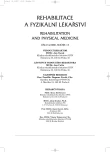Vertebrogenic Complaints and Stabilizing Function of Muscles – Diagnostics
Authors:
P. Kolář
Authors‘ workplace:
FN Motol, Praha
přednosta doc. PaedDr. P. Kolář
; Klinika rehabilitace a Centrum pro výzkum a léčbu bolestivých stavů
Published in:
Rehabil. fyz. Lék., 13, 2006, No. 4, pp. 155-170.
Category:
Original Papers
Overview
Back pains are the objects of attention of several medical disciplines. The clear communication requires a careful examination. From the standpoint of therapeutic possibilities the vertebrogenic disorder should be considered in the area of anatomical and biomechanical, viewed as a consequence of external strengths, but always in view of clinical evaluation of internal strengths acting upon the spine. In that we consider stabilization (postural) muscular function connected with the quality of controlling processes of CNS. Each pointed movement is transferred into the posture as a whole. The transfer of stabilization into the insertionassociated regions activates coordination of muscles strengthening the spine. Extensors of spine are harmoniously activated with deep flexors of the neck and muscular coordination between diaphragm, abdominal muscles and pelvic floor, which stabilize the spine from the anterior side by means of intraabdominal pressure. Under pathological conditions we observed insufficiency in the diaphragm function, disorder in timing during the balance of diaphragm with abdominal muscles, disorder in the initial position of thorax during stabilization of the spine connected with imbalance between upper and lower fixators of thorax and predominance in the function of superficial spine extensors. The examination of stabilization function is performed by means of specific tests. In spite of the differences of morphological findings and their clinical manifestations, exercise is the dominant procedure in conservative treatment for influencing the state by means of internal strengths. The therapeutic concept is dominated by education oriented to the change of muscular balance during stabilization.
Key words:
vertebrogenic complaints, spine extensors, spine stabilization, muscular balance, internal strengths
Labels
Physiotherapist, university degree Rehabilitation Sports medicineArticle was published in
Rehabilitation & Physical Medicine

2006 Issue 4
Most read in this issue
- Vertebrogenic Complaints and Stabilizing Function of Muscles – Diagnostics
- The Role of Diastasis Recti Abdominis in Genesis of Low Back Pain
- Pain as a Factor Indicating and Limiting Rehabilitation
- Muscle Dysbalance of Cervical Muscles
